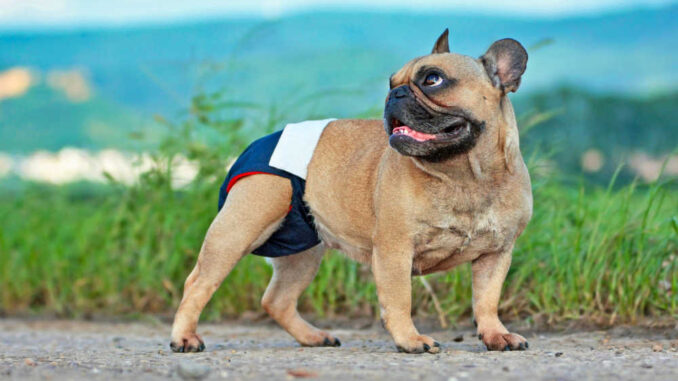
This article was updated on June 22nd, 2024

You may be prepared for the bleeding that will accompany your dog’s first heat cycle, but there are other bodily changes that might come as a surprise. When a female dog is “in heat” (estrus) and receptive to mating, there are multiple surges and drops in her hormone levels, which have varying effects on her body.
In this article, you will find pictures of female dogs in heat to help you understand what is normal, and when you might need to call your vet.
A swollen vulva is often one of the first signs that a dog is in heat
When your dog experiences their first heat cycle, between six and eighteen months of age, you may notice a dramatic swelling of the vulva. Most of the time, it is a normal finding, caused by the effects of estrogen on your dog’s reproductive tract. This picture shows the swollen vulva of a dog in heat:
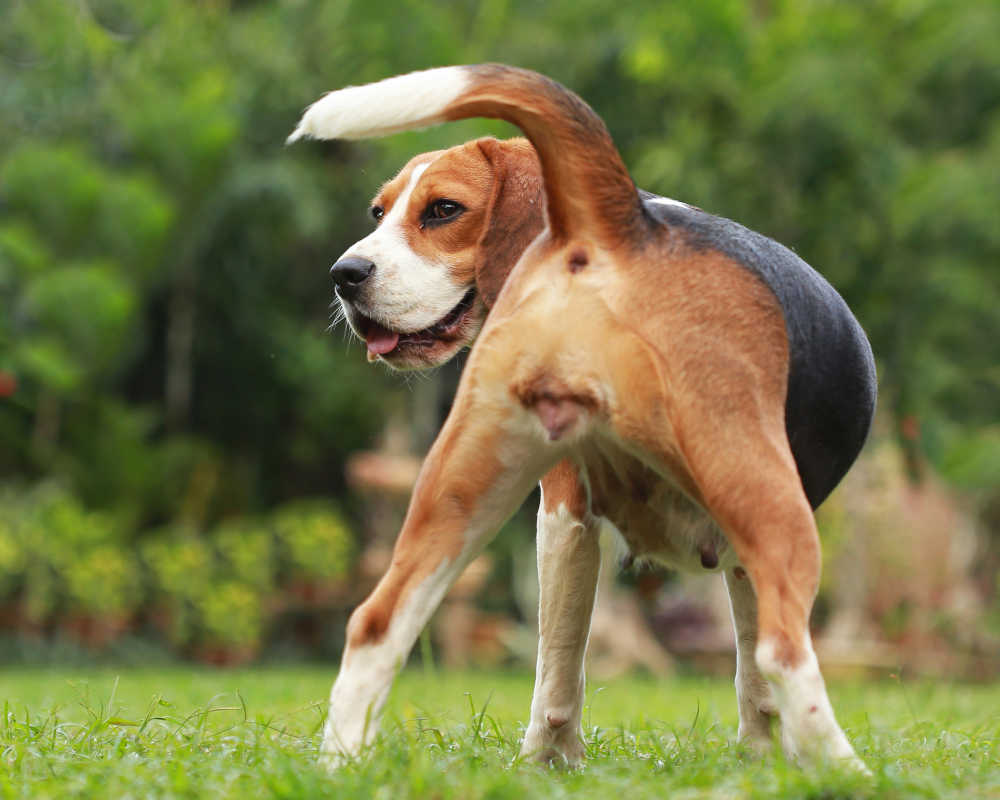
The vulva will remain enlarged throughout the dog’s fertile period, and then it will gradually decrease in size. It’s important to note, however, that your dog’s vulva may never return to the size that it was before her first heat cycle.
Dogs that have had one or more heat cycles will often have a vulva that remains permanently larger than that of dogs spayed before their first heat.
What a female dog looks like when in heat [3 pictures]
In these pictures below, you can see the appearance of a slightly swollen canine vulva, accompanied by a small amount of bloody vaginal discharge:
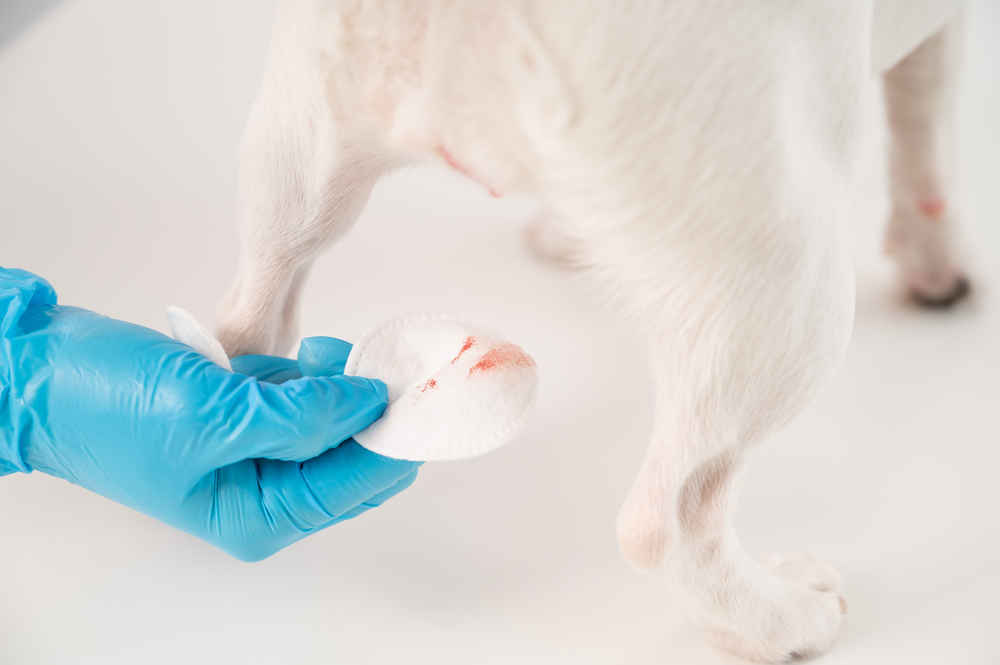
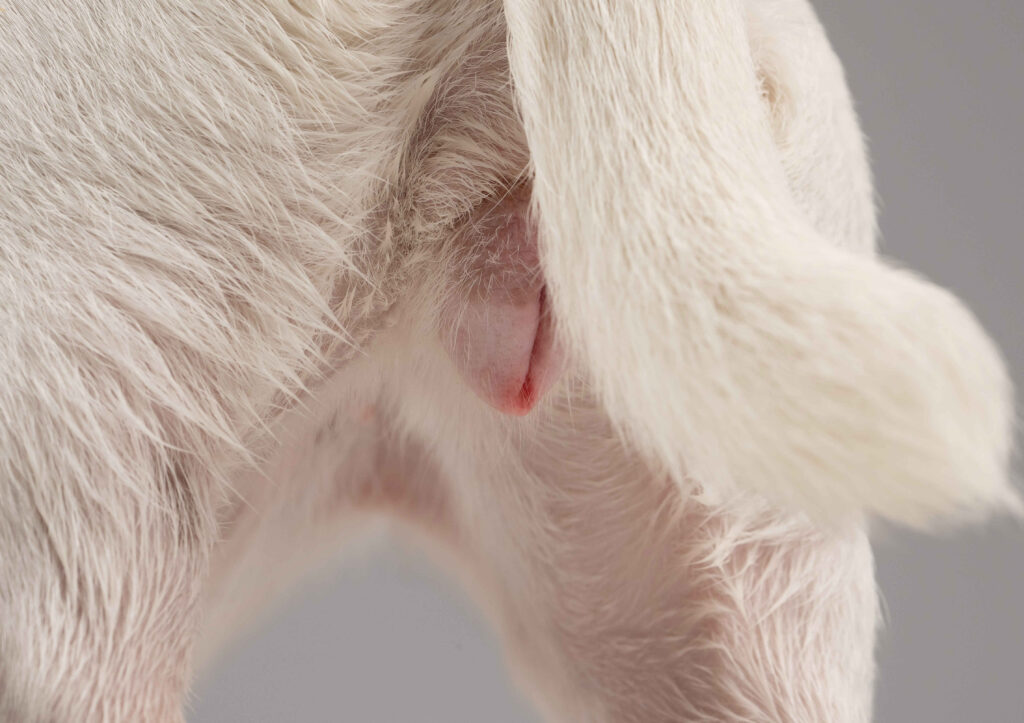
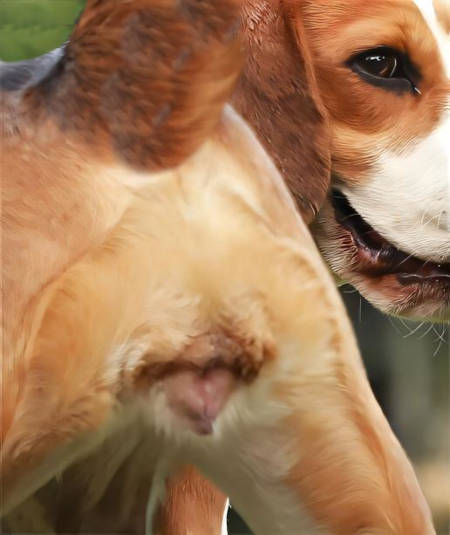
Signs your dog may be in heat:
Some of the signs are subtle or behavioral in nature. However, there are also clear visual cues that indicate a dog is in heat:
- Swelling or enlargement of the vulva
- Bloody or blood-tinged discharge from the vulva
- Urinating more often than usual
- Licking at the vulva more often than usual
- Increased mounting/humping behavior
- Increase in anxious behavior
- Roaming or increased interest in male dogs
The only way to prevent heat-related vulvar swelling is to have your dog spayed.
As long as your dog is experiencing heat cycles and is not spayed, you will continue to see episodes of vulvar swelling.
Spaying can also help your dog live a longer, healthier life
Spaying your dog can have the following medical benefits:
- Spaying your dog while they are relatively young can markedly decrease your dog’s risk of mammary (breast) cancer, a common health threat in dogs.
- Spaying your dog will prevent uterine cancer.
Spaying your female dog before her first heat provides the best protection against these diseases.
Call your vet if your dog is demonstrating extreme swelling or swelling that is occurring while they are NOT in heat
Vulvar swelling is normal when a dog is in heat. If you know that your dog is in heat and their vulva is mildly to moderately swollen, monitoring your dog at home is a reasonable option.
However, if your dog is demonstrating extreme swelling of the vulva or swelling that is occurring while they are not in heat, you should seek veterinary care. Your veterinarian will perform a thorough physical examination and diagnostic tests to determine the cause of your dog’s vulvar swelling and recommended treatments.
Medical issues causing vulvar swelling [issues to be aware of]
While swelling of the vulva is a common sign of heat, there are also medical conditions that may cause vulvar swelling. It’s important to be able to distinguish between heat and these potentially-serious conditions:
Top causes of abnormal swelling
Click here to see a picture showing a degree of swelling that may be normal in some dogs, but is likely abnormal or problematic swelling in most dogs. Let’s review the most common causes:
1. Vaginitis
While a dog’s heat cycle is accompanied by vulvar swelling and bloody discharge, you may also notice inflammation of the vulva and a purulent (pus-filled) discharge if your dog has vaginitis. This condition is common in young puppies, but can also occur in adult female dogs. Vaginitis may also be accompanied by redness around the vulva.
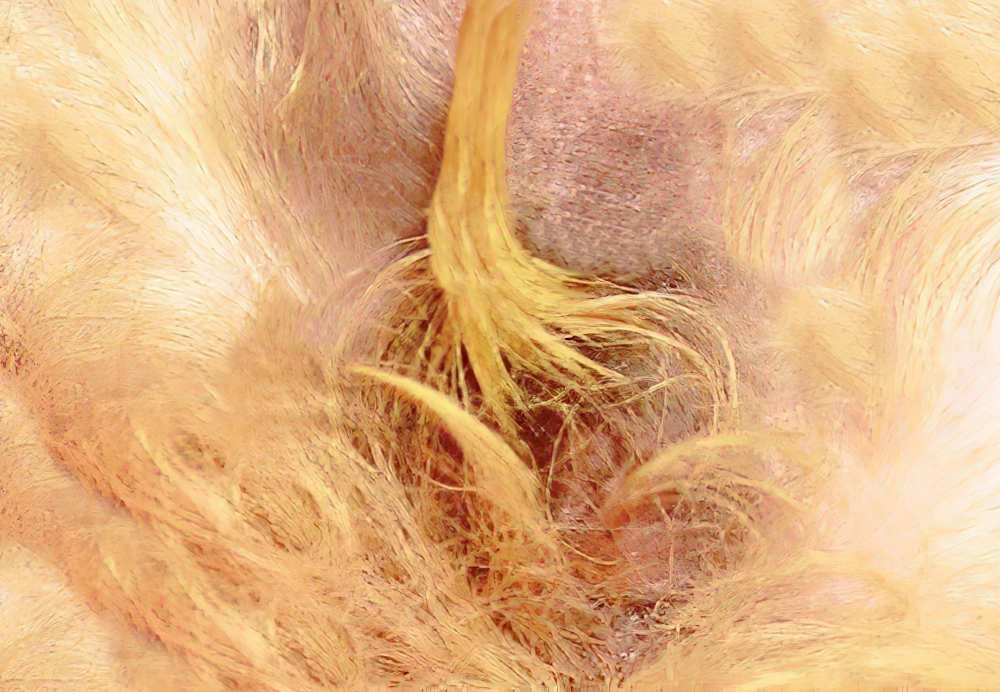
There are a variety of recommended treatments for vaginitis in dogs, depending on your dog’s overall condition and the severity of the vaginitis. See your veterinarian if you suspect that your dog may have vaginitis.
2. Vaginal hyperplasia
Vaginal hyperplasia is another condition that can cause swelling in the area of the vulva. In this condition, fluid-filled vaginal tissue prolapses from the vulva and is visible outside the body. This condition is most common in intact dogs and is associated with the effects of estrogen.
This picture may be shocking to some readers: click here to view.
If your dog has vaginal hyperplasia, they need veterinary care to prevent infection and injury to their prolapsed vaginal tissues. Your veterinarian will also likely recommend spaying your dog, to prevent future episodes of vaginal hyperplasia.
In some cases, vaginal hyperplasia can block a dog’s ability to pass urine. This is a life-threatening emergency and requires emergency veterinary care.
3. Rectal prolapse
In contrast to vaginal prolapse, rectal prolapse can affect both male and female dogs. In this condition, usually caused by gastrointestinal issues and/or excessive straining to defecate, a small amount of tissue prolapses from the rectum. Rectal prolapse is a medical emergency. Seek veterinary care immediately if you suspect rectal prolapse. Learn about about prolapse in dogs.
5 tips to help a dog in heat
Your dog’s heat cycle can be stressful for both you and your dog. Consider the following steps to reduce your dog’s stress:
1. Walk your dog during quiet times of the day.
Male dogs will be attracted to your dog’s scent. Walk her when fewer dogs will be outside.
2. Bathe your dog to control odors.
Most dogs will groom themselves to remove blood and vaginal discharge. Bathing your dog can help minimizing the amount of self-grooming that she needs to do
3. Distract your dog with play.
If your dog appears restless or anxious, interactive play can help distract her from her heat cycle.
4. Keep your dog on-leash and closely supervised.
In order to prevent unwanted mating, it’s important not to allow your dog outside unattended.
5. Have your dog spayed.
If you do not plan to breed your dog, you should have her spayed to prevent further heat cycles and help increase chances that your dog lives a happy & long life.
Interesting questions about the heat cycle
How often do dogs go into heat?
Most dogs go into heat every six months or twice yearly. However, some dogs may have as few as one heat cycle per year, while other dogs may have as many as three heat cycles in a year.
Is my dog in pain when in heat?
Being in heat isn’t painful, but it can cause some discomfort or restlessness. If your dog appears painful, consult your veterinarian.
What do I do if my female dog’s vulva is swollen but she is not in heat?
If your dog’s vulva is swollen and you know that she is not in heat, contact your veterinarian. Your veterinarian will perform a physical examination and laboratory tests to rule out infections, tumors, and other problematic causes of vulvar swelling.
Do female dogs go through a menopause stage?
Dogs do not experience menopause in the way that we see in humans. A dog’s heat cycles may become less frequent with age, but they do not typically stop completely. Most dogs can become pregnant throughout their lifespan.
Disclaimer: This website's content is not a substitute for veterinary care. Always consult with your veterinarian for healthcare decisions. Read More.


I have a 9 month old female chihuahua who is in heat. I also have a mastiff, German Shepherd, pit bull who weighs around 140 lbs. and is trying to mount her. Should I be worried?
Yes, there is always the potential for a mating and this is not a pregnancy that is advised, given the size difference. A c-section would be needed. We must keep them apart and I’d have one neutered ASAP to prevent any unwanted litters.
Dr Linda Simon MVB MRCVS
“The information on this website is not a substitute for in-person veterinary care. Always seek advice from your veterinarian if you have concerns about your pet’s medical condition.”
Is it normal for the inside of a dogs viginia to be red?
Hi there and thank you for this question.
The inside tissue can be quite dark pink, red or purple. It is very vascular, meaning there are lots of blood vessels, which give it its color.
However, this is not usually an area we would notice.
If it is that you can see the tissue looks more red externally, it is swollen, she is licking at it or it has been bothering her, this likely indicates an issue such as a vaginitis, UTI or infection.
In this case, she should see her vet who can examine the area and perhaps swab it for infection if concerned.
It may be she needs e.g. some anti inflammatories.
If she has been licking, we should prevent this by using a buster collar.
“The information on this website is not a substitute for in-person veterinary care. Always seek advice from your veterinarian if you have concerns about your pet’s medical condition.”
How long does a cycle last? And how long is normal for selling of vulva to last? Thankyou
Hello and thank you for your question!
This is Dr Linda, one of the website’s vets.
How long a season lasts depends on several factors including a dog’s age and breed. However, for most dogs their cycle will last around 3 weeks. Once your bitch has got an established routine, they should have regular heat cycles that are evenly spaced apart and last roughly the same time.
They will not bleed for this entire time; most only bleed for around half of this time. Similarly, they are not fertile for this entire time.
For most bitches, the vulva stops being swollen once the cycle has finished, so is swollen for about 3 weeks.
“The information on this website is not a substitute for in-person veterinary care. Always seek advice from your veterinarian if you have concerns about your pet’s medical condition.”
I have called my veterinarian 4 times with questions about the heat cycle/ length of time. I keep getting the same response that it’s normal especially for the first time she’s had it. We noticed the drops of blood beginning December 22 and now we are on weak six and there still are a few drops of blood here in there. What is a length of time that really is normal?
Hi Laura and thanks for your question about your dog. A typical heat cycle will only last about 3 weeks, with the dog bleeding for about 10 days or so. However, there can be exceptions to this. Some dogs will bleed for longer and some will experience a ‘split heat’ cycle whereby they seem to come into season, but do not ovulate, and then come back in again fully. This can prolong everything.
Having said the above, as it has been 6 weeks, I would schedule a vet check. They can assess your dog and check for any underlying issues such as a clotting disorder, UTI or vaginitis. They can also ensure she is not anaemic. By assessing her vaginal cells, they can determine at which stage of her cycle she is currently at, which will help us determine what exactly is going on.
“The information on this website is not a substitute for in-person veterinary care. Always seek advice from your veterinarian if you have concerns about your pet’s medical condition.”
I have a female golden retriever that has been exhibiting signs of heat since September 22nd, 2023. Today is October 19th and the symptoms aren’t improving. Her progesterone levels have been at a 1.2 for 3 weeks. Her vulva is swollen, she’s urinating quite a bit and my boy has been going crazy.. he sniffs and licks her as well as tasting her pee. She isn’t lethargic, and appetite is still good. I just don’t understand what’s going on. Help?
Hi there and thank you for your question. I’m sorry to hear you’ve been dealing with this issue, and can imagine it has been stressful given there is a male dog in the home.
Given her signs, I would consider a vaginitis or UTI causing her frequent urination and swelling; this can be confused by the male for a bitch being in season even when they are not.
Another consideration, if that Progesterone levels is measured in ng/ml, she may be experiencing a prolonged pro-oestrus. The level should rise as she ovulates.
She may have a ‘persistent oestrus’ due to e.g. a hormonal imbalance, exposure to oestrogen (e.g. from a human in the home using certain medication), an ovarian cyst etc.
It may also be that this is an anovulatory cycle. This is not common in females, but can occur, and they usually come into their next heat cycle earlier than expected.
I’d use a buster collar to stop her licking her vulva if she is doing this.
I’d also consider a vaginal swab for infection and urine analysis.
If issues persist, it is worth consulting a reproduction specialist / endocrinologist who may perform vaginal cytology, some specific blood tests and a reproductive scan, to get a clearer answer.
“The information on this website is not a substitute for in-person veterinary care. Always seek advice from your veterinarian if you have concerns about your pet’s medical condition.”
My dog’s vulva does not become red when she is in heat but gets black & her the vulva does not get too big.
Hey there and thanks for your query.
Typically, during a season, the vulva becomes a pink/red color and becomes swollen, due to the increased blood flow and fluid build up. Some dogs lick the area a lot more, and this can lead to some darker discoloration, especially if they have white fur/light skin. Any blackness is likely to be pigment.
The vulva is not always very much larger, especially in younger females and those experiencing their first or second seasons. Size can fluctuate during the season. There are lots of varieties of normal!
“The information on this website is not a substitute for in-person veterinary care. Always seek advice from your veterinarian if you have concerns about your pet’s medical condition.”